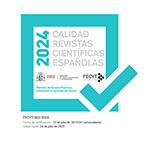Framing effectiveness in social campaigns: a gender issue
Abstract
Introduction: During the first months of the COVID-19 pandemic, public health measures to reduce the transmission of the virus were the only measures that health institutions could adopt. Therefore, numerous social publicity campaigns were launched to raise awareness and promote their adoption.
Aim/Objectives: The aim of this study is to identify the type of persuasive message that is most effective in social advertising campaigns designed to improve attitudes towards compliance with COVID-19 pandemic prevention measures among young Spaniards. It also aims to analyse the emotional impact generated by each campaign according to gender.
Methodology: An experimental design was carried out, with three conditions in three groups (3x1), one for each campaign selected. This allowed us to compare the effects of different communication strategies and their results, differentiating by gender.
Results and discussion: The results show that the loss-framed message strategy was more effective in generating attitudinal changes in young people. In addition, the study clarifies the differential impact of the campaigns between men and women.
Contribution/originality of the contribution: The study presented highlights that the impact of persuasive strategies used in social communication campaigns if gender sensitive. It is therefore necessary to incorporate the gender variable in the design of social campaigns. Those responsible for health institutions should include specific strategies for men, if they really want to mobilise and achieve results with these actions.
Downloads
Article download
License
In order to support the global exchange of knowledge, the journal Investigaciones Feministas is allowing unrestricted access to its content as from its publication in this electronic edition, and as such it is an open-access journal. The originals published in this journal are the property of the Complutense University of Madrid and any reproduction thereof in full or in part must cite the source. All content is distributed under a Creative Commons Attribution 4.0 use and distribution licence (CC BY 4.0). This circumstance must be expressly stated in these terms where necessary. You can view the summary and the complete legal text of the licence.











